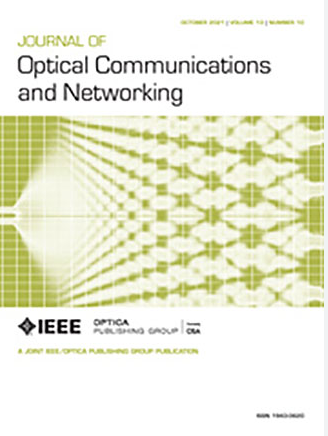在大规模光学卫星网络中实现最佳吞吐量的双相路由选择方案
IF 4
2区 计算机科学
Q1 COMPUTER SCIENCE, HARDWARE & ARCHITECTURE
引用次数: 0
摘要
在大规模光学卫星网络(LS-OSN)中,成百上千颗低地球轨道(LEO)卫星将通过激光链路相互连接,以高吞吐量和低延迟为特点覆盖全球。LS-OSN 为建立一个全面互联的智能世界提供了一个极具吸引力的战略。然而,由于卫星绕地球运行的动态性质,LS-OSN 拓扑结构经常发生变化。因此,迫切需要高效的路由算法,不仅能满足大规模的流量需求,还能迅速适应这些不断变化的拓扑结构。针对有特定带宽要求的服务的传统路由算法往往在计算速度或吞吐量效率方面大打折扣。为此,本研究引入了基于流量优化和分解(FOND)的路由方案。该方案旨在缩短计算时间,同时保持最佳网络吞吐量。在 FOND 方案的基础上,我们进一步设计了两种启发式算法:基于流量的贪婪路径(FGP)和基于流量的贪婪宽度(FGW)。288颗卫星星座网络的仿真结果表明,在路由计算时间方面,FGP和FGW都优于同类方法,同时还能保持相当于100%网络容量的稳定吞吐量。值得注意的是,FGP 表现出了惊人的能力,与基于 Dijkstra 算法原理的增量-最宽路径(IWP)基线算法相比,FGP 将路由计算时间减少了 0.23%。本文章由计算机程序翻译,如有差异,请以英文原文为准。
Biphase routing scheme for optimal throughput in large-scale optical satellite networks
In the large-scale optical satellite network (LS-OSN), hundreds to thousands of low Earth orbit (LEO) satellites will be interconnected via laser links, offering global coverage characterized by high throughput and low latency. LS-OSNs present an attractive strategy to cultivate a comprehensively connected, intelligent world. However, the dynamic nature of the satellites, as they orbit the Earth, results in frequent changes in the LS-OSN topology. Thus, there is a pressing need for efficient routing algorithms that not only cater to massive traffic demands but also swiftly adapt to these constant topological changes. Traditional routing algorithms for services with specific bandwidth requirements often compromise on either computational speed or throughput efficiency. In response, this study introduces a routing scheme based on flow optimization and decomposition (FOND). This seeks to shorten the computation time while preserving optimal network throughput. Expanding upon the FOND scheme, we further devised two heuristic algorithms: the flow-based greedy path (FGP) and the flow-based greedy width (FGW). Simulation results from a 288-satellite constellation network indicate that both the FGP and FGW outpace contemporary methods in terms of the routing computation time while maintaining a consistent throughput equal to 100% of the network capacity. Notably, the FGP has exhibited an impressive capability, reducing the routing computation time to 0.23% compared to the baseline incremental-widest-path (IWP) algorithm, which operates on Dijkstra’s algorithm principles.
求助全文
通过发布文献求助,成功后即可免费获取论文全文。
去求助
来源期刊
CiteScore
9.40
自引率
16.00%
发文量
104
审稿时长
4 months
期刊介绍:
The scope of the Journal includes advances in the state-of-the-art of optical networking science, technology, and engineering. Both theoretical contributions (including new techniques, concepts, analyses, and economic studies) and practical contributions (including optical networking experiments, prototypes, and new applications) are encouraged. Subareas of interest include the architecture and design of optical networks, optical network survivability and security, software-defined optical networking, elastic optical networks, data and control plane advances, network management related innovation, and optical access networks. Enabling technologies and their applications are suitable topics only if the results are shown to directly impact optical networking beyond simple point-to-point networks.

 求助内容:
求助内容: 应助结果提醒方式:
应助结果提醒方式:


